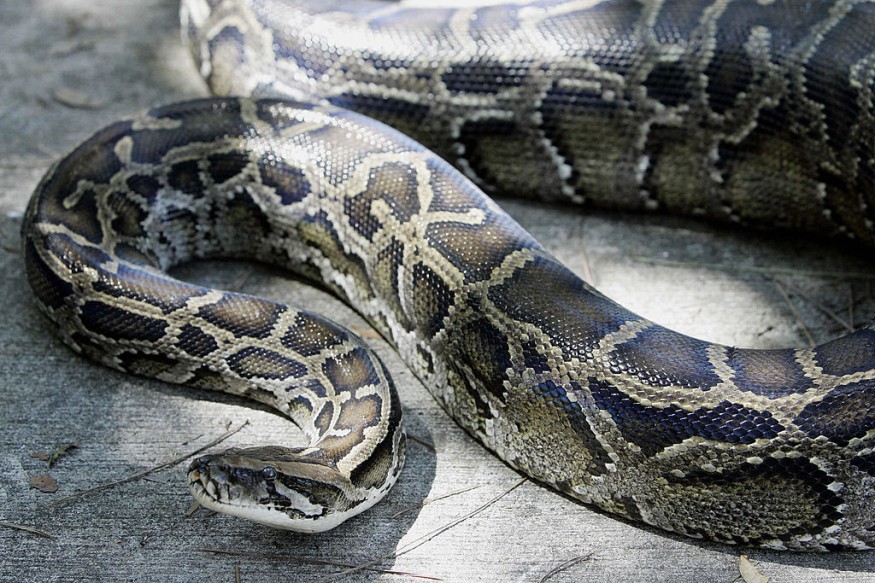Researchers used another python as bait to coax the most enormous Burmese python ever seen in Florida out of its hiding location in the Everglades.
The invasive pythons have successfully reproduced in Florida's southern areas. They were first brought there in the 1970s. Pythons feed on numerous local birds and animals, including alligators or domestic dogs.
One of the largest snake species in the world is the Burmese python. Since they wrap their bodies around their prey before consuming them, they are known as constrictors.

Largest Python in Florida Found
A giant python had been caught in Florida, according to National Geographic Tuesday. It is the biggest female member of its species in the state and anywhere else outside of the region's native environment.
The record-breaking female Burmese python weighed 215 pounds and measured 18 feet long.
The team used scout pythons like Dionysus, or Dion, a roughly 12-foot-long male, as bait. They attached a global positioning system (GPS) tracker to the body of the "scout snake," and it proved effective because it led them to the record-breaking female python.
Aside from being the largest of its kind, the female python produced the most number of follicles or eggs. Researcher Ian Bartoszek counted a total of 122 follicles, which was considered the new known upper limit for reproduction. For them, it was not surprising given the snake's massive size.
Kristen Hart, an ecologist with the U.S. Geological Survey Wetland and Aquatic Research Center and a collaborator with the conservancy team, said massive female pythons have very high reproductive potential and they pass on their good genes to their offsprings to preserve their species.
The team is working on controlling the population of the python because they have been exploding in the wild and have already altered the ecosystem by consuming a wide variety of native species.
ALSO READ : Massive Python With Rainbow-Colored Scales That Can Grow Up To 25 Feet Long Goes Viral [WATCH]
Never-Ending Snake Hunt in Florida
Snake wrangling has grown in popularity in recent years, Outdoor Life said. However, due to the overwhelming quantity of pythons in the Sunshine State, the fight to eradicate Burmese pythons from the Everglades may never end.
The current estimates of their statewide population varies between 30,000 and 300,000. The issue started in the 1990s by a few irresponsible pet owners and got out of hand 30 years later. You may begin to understand the magnitude of Florida's python problem when you multiply that many camouflaged reptiles by 1.5 million acres of impenetrable marshes.
Burmese pythons are at the top of Florida's least-wanted list because they are indigenous to Southeast Asia's rainforests and green marshes. The United States Geological Survey estimates that they are responsible for about 90% of the reductions in certain native animal species. After they get to a length of about six feet, the snakes have no natural predators in the wild.
Additionally, some studies indicate that the species' distribution is moving further north, making controlling their expansion even more crucial. Finding huge, egg-laden females and killing them before they can deposit their eggs is one of the most efficient methods to achieve this. That is precisely what Bartoszek and the team at the Conservancy are concentrating on.
About Burmese Pythons
Burmese pythons (Python bivittatus), which originated from Southeast Asia, are not native to Florida, according to the Florida Fish and Wildlife Conservation (FWC). They are classified as invasive species because they are harmful to local fauna.
Animal protection rules in the Sunshine State also contribute to the persistence of non-native reptile species. As an exception, a private property owner may decide to kill them humanely if they enter a person's house or neighborhood.
Nearly all Burmese pythons in Florida reach 6 to 10 feet. Their Southeast Asian equivalents, however, may reach heights of up to 20 feet.
Burmese pythons are much harder to see in the extensive marshes, wooded regions, and subtropical forests of the Everglades and surrounding areas, according to Live Science, despite being larger than other native snake species in Florida.
Python trackers at the Conservancy of Southwest Florida, a Naples-based group, implant GPS trackers into male pythons before sending these "scout snakes" slithering into the wild to minimize these invasive populations by luring reproductively active females out of hiding.
RELATED ARTICLE : 6-Foot Rat-Eating Snakes, the Biggest Serpent in Britain Breeding Again in UK After 10,000 Years
Check out more news and information on Animals in Science Times.












